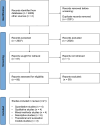Integrating virtual patients into undergraduate health professions curricula: a framework synthesis of stakeholders' opinions based on a systematic literature review
- PMID: 38969998
- PMCID: PMC11225252
- DOI: 10.1186/s12909-024-05719-1
Integrating virtual patients into undergraduate health professions curricula: a framework synthesis of stakeholders' opinions based on a systematic literature review
Abstract
Background: Virtual patients (VPs) are widely used in health professions education. When they are well integrated into curricula, they are considered to be more effective than loosely coupled add-ons. However, it is unclear what constitutes their successful integration. The aim of this study was to identify and synthesise the themes found in the literature that stakeholders perceive as important for successful implementation of VPs in curricula.
Methods: We searched five databases from 2000 to September 25, 2023. We included qualitative, quantitative, mixed-methods and descriptive case studies that defined, identified, explored, or evaluated a set of factors that, in the perception of students, teachers, course directors and researchers, were crucial for VP implementation. We excluded effectiveness studies that did not consider implementation characteristics, and studies that focused on VP design factors. We included English-language full-text reports and excluded conference abstracts, short opinion papers and editorials. Synthesis of results was performed using the framework synthesis method with Kern's six-step model as the initial framework. We appraised the quality of the studies using the QuADS tool.
Results: Our search yielded a total of 4808 items, from which 21 studies met the inclusion criteria. We identified 14 themes that formed an integration framework. The themes were: goal in the curriculum; phase of the curriculum when to implement VPs; effective use of resources; VP alignment with curricular learning objectives; prioritisation of use; relation to other learning modalities; learning activities around VPs; time allocation; group setting; presence mode; VPs orientation for students and faculty; technical infrastructure; quality assurance, maintenance, and sustainability; assessment of VP learning outcomes and learning analytics. We investigated the occurrence of themes across studies to demonstrate the relevance of the framework. The quality of the studies did not influence the coverage of the themes.
Conclusions: The resulting framework can be used to structure plans and discussions around implementation of VPs in curricula. It has already been used to organise the curriculum implementation guidelines of a European project. We expect it will direct further research to deepen our knowledge on individual integration themes.
Keywords: Curriculum development; Framework synthesis; Systematic review; Virtual patients.
© 2024. The Author(s).
Conflict of interest statement
The authors declare no competing interests.
Figures
Similar articles
-
Learner preferences regarding integrating, sequencing and aligning virtual patients with other activities in the undergraduate medical curriculum: A focus group study.Med Teach. 2013 Nov;35(11):920-9. doi: 10.3109/0142159X.2013.826790. Epub 2013 Sep 4. Med Teach. 2013. PMID: 24003850
-
Curricular integration of virtual patients: a unifying perspective of medical teachers and students.BMC Med Educ. 2019 Nov 9;19(1):416. doi: 10.1186/s12909-019-1849-7. BMC Med Educ. 2019. PMID: 31706296 Free PMC article.
-
Student and educator experiences of maternal-child simulation-based learning: a systematic review of qualitative evidence protocol.JBI Database System Rev Implement Rep. 2015 Jan;13(1):14-26. doi: 10.11124/jbisrir-2015-1694. JBI Database System Rev Implement Rep. 2015. PMID: 26447004
-
A scoping review: virtual patients for communication skills in medical undergraduates.BMC Med Educ. 2022 Jun 3;22(1):429. doi: 10.1186/s12909-022-03474-9. BMC Med Educ. 2022. PMID: 35659213 Free PMC article.
-
Patient safety education in undergraduate medical education through a global lens: a scoping review.BMC Med Educ. 2025 Apr 16;25(1):544. doi: 10.1186/s12909-025-07159-x. BMC Med Educ. 2025. PMID: 40241068 Free PMC article.
Cited by
-
Impact of simulation training on communication skills and informed consent practices in medical students- a randomised controlled trial.BMC Med Educ. 2025 Jul 18;25(1):1078. doi: 10.1186/s12909-025-07671-0. BMC Med Educ. 2025. PMID: 40682099 Free PMC article. Clinical Trial.
-
Perspectives on enhancing clinical informatics education in the artificial intelligence era.J Clin Inform. 2024;1(1):4496. Epub 2024 Dec 4. J Clin Inform. 2024. PMID: 40051784 Free PMC article.
References
-
- Consorti F, Mancuso R, Nocioni M, Piccolo A. Efficacy of virtual patients in medical education: a meta-analysis of randomized studies. Comput Educ. 2012;59:1001–8. doi: 10.1016/j.compedu.2012.04.017. - DOI
-
- Kononowicz AA, Woodham LA, Edelbring S, Stathakarou N, Davies D, Saxena N, et al. Virtual Patient Simulations in Health Professions Education: systematic review and Meta-analysis by the Digital Health Education Collaboration. J Med Internet Res. 2019;21:e14676. doi: 10.2196/14676. - DOI - PMC - PubMed
Publication types
MeSH terms
Grants and funding
LinkOut - more resources
Full Text Sources
Miscellaneous




